Building Internet of Things-Enabled Mobile Apps: Trends and Applications
29 May 23 

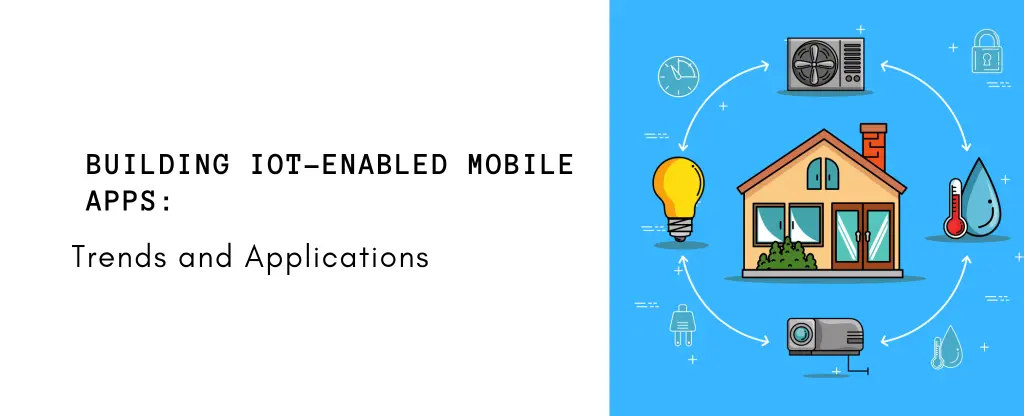
The growth of various current technologies is causing inventive and significant improvements in the mobile app development market to occur quickly. One of these technologies is the Internet of Things. IoT-linked devices are currently in use with a market value of about 43 billion USD, and by 2025, this can increase three times more.
In addition, people are using IoT solutions in industries, including health services, retail, agriculture, and more. Therefore, it is transparent that the number of IoT apps is growing daily. Additionally, companies are turning to IoT mobile app development to expand their operations quickly. IoT may support contact and communication at all levels. IoT app development services are in demand due to the proliferation of these apps and their simplicity of use.
What is IoT?
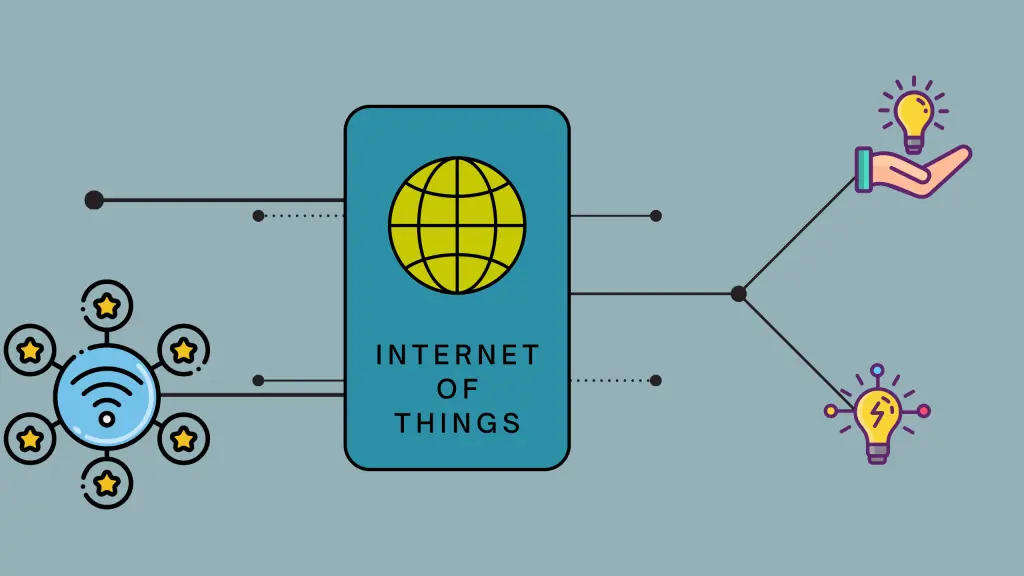
The Internet of Things, or IoT, combines the internet with physical objects. The physical objects connected to the internet include smartphones, household appliances, healthcare devices, automobiles, and other manufacturing devices. These objects interact mutually and transfer data without the integration of a human.
IoT aids users in controlling and monitoring their smart devices, even in an isolated area. This enables the users to have an effective, secure and more innovative environment. The IoT enabled objects to gather and exchange data providing users with more authority and comfort in their everyday activities.
Driving Factors for Developing IoT-Enabled Mobile Apps
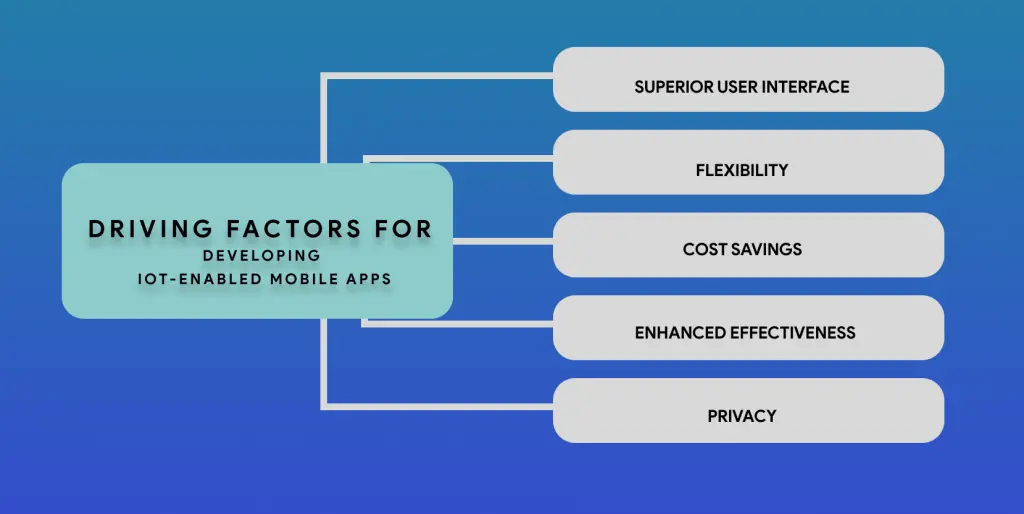
Superior User Interface
The IoT enables developers to improve user interaction with their products. Internet of Things (IoT) applications provide features that facilitate user life. Live information interchange, remote management, and automation are some of these capabilities.
Enhanced Effectiveness
Mobile IoT apps can increase productivity by reducing the need for human labor. In addition, connected data may be collected and sent quickly, allowing designers to streamline particular operations. Nevertheless, the IoT increases the productivity and cost-effectiveness of mobile apps.
Cost Savings
IoT mobile apps are often cheaper than standard web or desktop applications. Because cloud computing has reduced operational expenses, this is the case. Additionally, these applications require minimal upkeep, which allows firms to save money over time.
Flexibility
Due to the tremendous scalability of IoT mobile apps, you can quickly add novel functions and connections as technology evolves. You can benefit from new opportunities and swiftly adjust to alterations in the IoT industry.
Privacy
Companies may guarantee the safety of their customer information using an IoT mobile app. IoT solutions safeguard data with robust security mechanisms and methods for verification.
Application of IoT-Enabled Mobile Apps
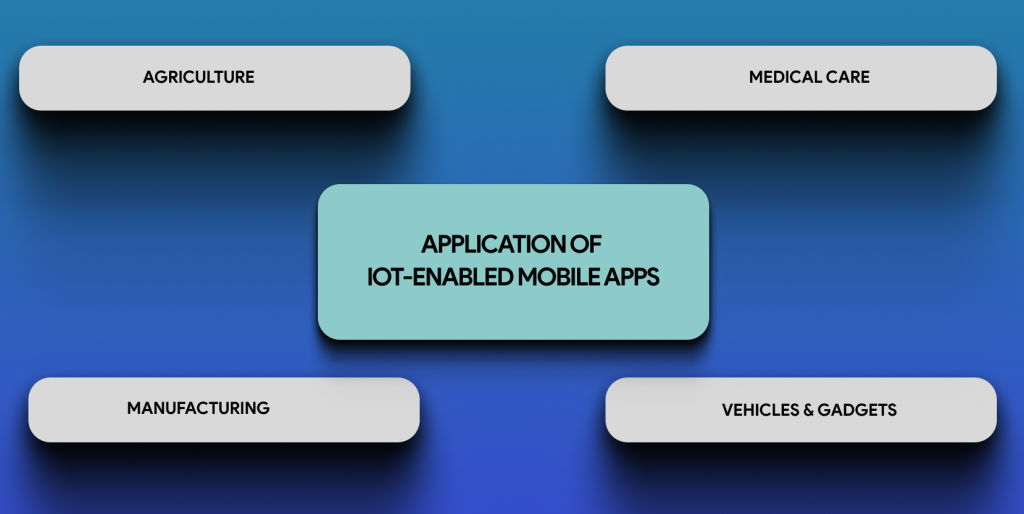
Agriculture
Agricultural drones, greenhouse automation, temperature tracking, livestock tracking, water management, and other IoT applications for agriculture are just a few. The information obtained by monitoring systems assists farmers in improving practically every aspect of their operation.
This focuses on raising cattle and growing crops. IoT has significantly improved farming by enabling better use of the property by tracking the soil, irrigation, weather, temperature, and other factors.
Medical Care
Through IoT mobile applications, current healthcare organizations have been leveraging real-time health systems to improve the holistic management of patients, diagnosis, and upkeep of medical devices.
Manufacturing
One of the most significant IoT investors is the industrial sector.
IoT plays a crucial role in the following:
- Cost-cutting by optimizing systems.
- Managing resources
- Automobiles in supply chains
- Regulating the process of manufacturing
- Reduces waste
Vehicles & Gadgets
Digital assistants, the primary components and characteristics of IoT, have become more prevalent in the past decade, as have home and workplace systems for automation. It is the primary force behind the modern vehicle.
Air quality is categorized and visualized inside automotive systems by a mobile Internet of Things air pollution monitoring device. In addition, a monitoring system gives data about navigation and telemetry and enables the car systems to link with other gadgets for an internet connection.
Trends in IoT App Development
The Internet of Things (IoT) network is constantly growing and changing as designers build new hardware that opens up new possibilities for upcoming software applications. Therefore, think about the emerging patterns to better understand the sorts of applications that will be successful quickly.

Privacy is the Top Priority
IoT platforms have long been seen as vulnerable targets for cybercriminals. However, because of the significance of the analyzed and saved data and the expanding function of such systems, IoT app developers are now paying more significant concern to security.
Sadly, not every IoT gadget can yet be fitted with the privacy protections that our modern laptops and desktops have. That, however, is anticipated to alter. Therefore, the applications themselves also include this description.
Using technologies like biometric login, machine-to-machine verification, and other AI- and ML-powered solutions for data security will become increasingly common. These technologies will be implemented in mobile applications and intelligent devices that handle confidential information.
Better Data Analytics
This is anticipated to become a significant trend in the world of IoT. As a result, IoT mobile applications have been integrated with improved AI-based solutions to offer superior decision assistance for various businesses.
Application users become empowered to make more innovative and more efficient judgments regarding their enterprises and personal lives with access to improved analytics. And it’s anticipated that consumer demand will increase over the coming few years given the novel opportunities these capabilities provide.
Application Hybridization
As you may already be aware, native applications can only operate on the platform for which they were designed. Thus, only users of devices that support that platform may download them.
Despite historically performing better, these hybrid apps may now be created using cutting-edge coding methods, new technology, and creative UX design strategies. Hybrid applications are becoming more popular due to their adaptability and ease of collecting user information from one location.
Giving UI/UX Design Consideration
Due to the requirement of interfacing with a range of system elements, IoT technologies necessitate complicated app architectures, which diverge from typical mobile applications’ UI/UX design methods.
For connection to different system components, an IoT app typically has to have a variety of interfaces. However, no matter how extensive the app’s features are, developers must offer users smooth operation and simple navigation.
Open-Source Programming
In the IoT mobile market, open-source software development is a developing trend. Mobile device frameworks incorporate IoT solutions and innovations, helping developers to develop apps easily. The open-source framework for development also guarantees the openness of all processes.
Thereby, the developers are benefited from working together more efficiently. As a result, they can create compelling, sophisticated mobile apps. The apps are tailored specifically to a company’s ongoing requirements. As a consequence, the developed app offers companies better value.
Sophisticated Personalization
IoT technologies need to create highly engaging applications and offer chances for personalization to provide enhanced customer service and comfort. The software may be customized to guarantee it stays functional and suitable despite shifting circumstances and demands.
Designers can develop apps that meet the needs of users. You may set yourself apart from rivals by using versatile, rich-in-feature applications that provide customers with sophisticated options.
Challenges in IoT App Development
IoT application development can be challenging and demanding. Here are a few difficulties IoT developers encounter.
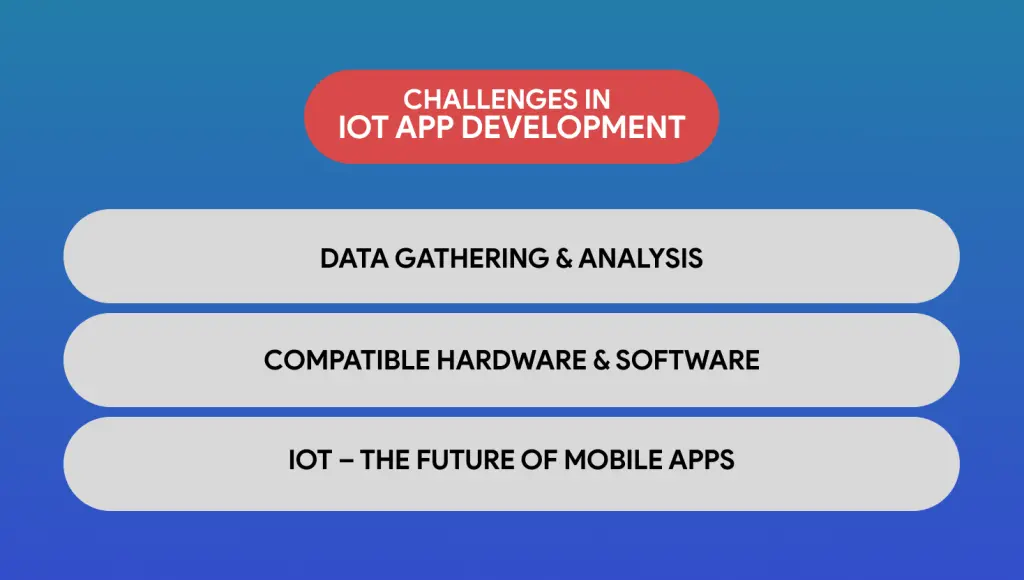
Data Gathering & Analysis
It might not be easy to process the enormous volumes of data that IoT devices can produce. Therefore, developers must know the data collection and storage processes to develop efficient IoT systems.
Safety & Confidentiality
While it involves the IoT, safety and confidentiality are important considerations. Applications for the Internet of Things must be safe enough to shield personal information from cybercriminals and other intruders.
Compatible Hardware & Software
Applications for the Internet of Things must run on different hardware and software platforms. In addition, because IoT devices come in various designs, guaranteeing adaptability may be challenging.
IoT – The Future of Mobile Apps
Have you ever researched the paramount growth of IoT in the current business environment and marketplace? If not, there is positive growth in the IoT market. Researchers and professionals anticipate that the IoT market will grow by 1.6 trillion dollars by 2025, helping many businesses and developers innovate and grow. In addition, IoT-enabled mobile apps gain wide acceptance as more people depend heavily on connected devices.
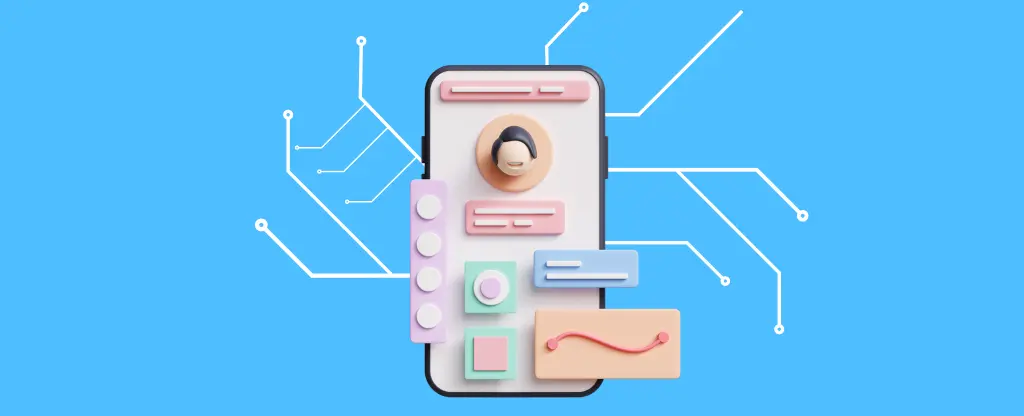
IoT-enabled mobile apps offer a pool of opportunities for developers and businesses. However, why are mobile apps so popular and valuable? Apps built on the Internet of Things allow customers more significant influence over automated homes and health monitoring gadgets.
These gadgets use cloud computing to allow quicker data transmission rates and more privacy. In addition, cloud technologies make mobile application development over the IoT network simpler. The way we use technology is changing due to linked gadgets, making the globe more interconnected.
Therefore, the need for IoT-based apps and the Internet of Things will increase. Upcoming mobile app development will involve creating more than just apps for tablets and smartphones. Instead, the Internet of Things will provide interrelated, productive, and secure interactions.
- Android Development3
- Artificial Intelligence27
- Classified App3
- Custom App Development2
- Digital Transformation11
- Doctor Appointment Booking App13
- Dropshipping1
- Ecommerce Apps38
- Education Apps2
- Fintech-Apps35
- Fitness App2
- Flutter3
- Flutter Apps19
- Food Delivery App5
- Grocery App Development1
- Grocery Apps3
- Health Care7
- IoT2
- Loyalty Programs9
- Matrimony Apps1
- Microsoft1
- Mobile App Maintenance2
- Mobile Apps120
- Product Engineering5
- Progressive Web Apps1
- Saas Application2
- Shopify7
- Software Development1
- Taxi Booking Apps7
- Truck Booking App5
- UI UX Design8
- Uncategorized4
- Web App Development1









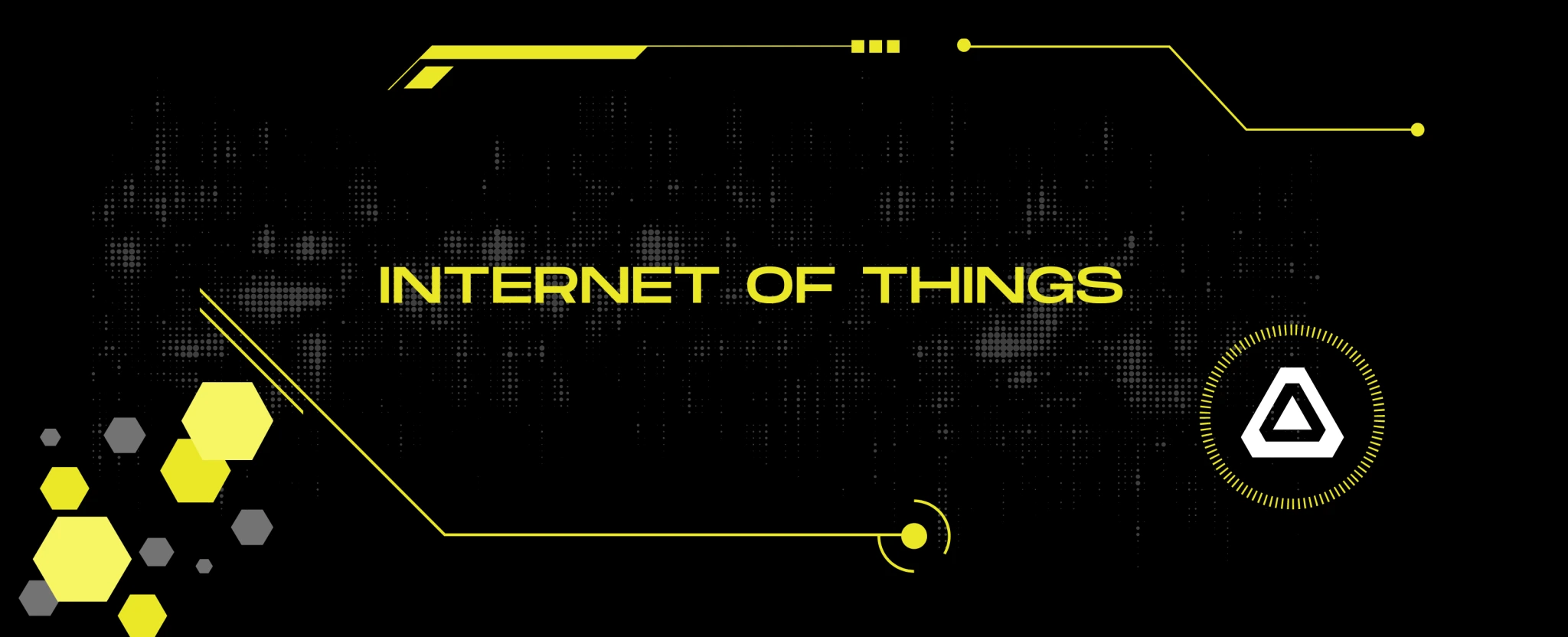






Comments